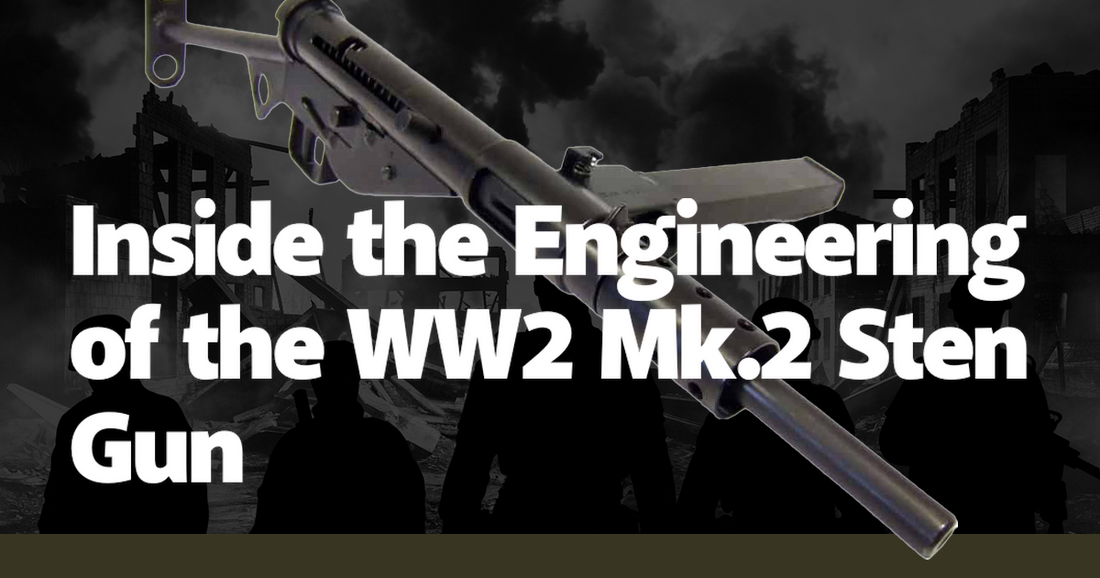The Mk.2 Sten Gun, a symbol of British ingenuity during World War II, stands as a testament to the necessity-driven innovation of wartime. Designed in 1941, the Sten was a response to the desperate need for a simple, cost-effective submachine gun that could be produced rapidly and in large quantities. The name "Sten" itself is derived from the initials of its chief designers, Major Reginald V. Shepherd and Harold Turpin, combined with "Enfield," the location of the Royal Small Arms Factory. The urgency of the war effort dictated that the weapon be both easy to manufacture and reliable under the harshest conditions. This led to the creation of a firearm that, while crude in appearance, was remarkably effective in its role.
The Sten's engineering was a study in minimalist design. Constructed primarily from stamped metal parts, it featured a simple blowback operation and fired from an open bolt. This simplicity was intentional; the fewer the parts, the easier and cheaper it was to produce. In fact, the Mk.2 Sten could be assembled from just 47 components, and its production cost was a mere fraction of that of its contemporaries. The barrel, a critical component, was often sourced from outdated or surplus rifles, further reducing costs. This frugality did not come without its drawbacks, however, as the Sten was notorious for its propensity to jam if not properly maintained and its magazine was particularly prone to feeding issues.
Despite these shortcomings, the Sten quickly became a favorite among British and Allied forces, not least because of its ease of use. With a rate of fire of approximately 500 rounds per minute, it provided the kind of close-quarters firepower that was invaluable in urban combat and trench warfare. Its compact size and light weight made it ideal for paratroopers and resistance fighters alike. Anecdotes from the field often highlight the Sten's role in guerrilla warfare, with resistance groups across Europe relying on its simplicity and the ease with which it could be hidden and transported. The gun's very crudeness became a virtue in the hands of those who needed a reliable weapon that could be quickly disassembled and reassembled.
One of the most compelling stories of the Sten's impact comes from the Norwegian resistance. In 1943, a group of Norwegian commandos used Sten guns in the daring Operation Gunnerside, which aimed to sabotage the Vemork heavy water plant and cripple Nazi Germany's atomic bomb project. The lightness and portability of the Sten allowed the commandos to traverse the rugged Norwegian terrain and carry out their mission with remarkable efficiency. This operation is often cited as one of the most successful acts of sabotage in the war, and the Sten gun played a crucial role in its execution.
The Sten's design also lent itself to easy modification, a feature that was exploited by various resistance groups and even regular army units. Silencers, extended barrels, and even makeshift stocks were added to tailor the weapon to specific needs. One notable variant was the silenced Mk.2S, used by the British Special Operations Executive (SOE) for clandestine operations. The ability to customize the Sten made it a versatile tool in the hands of those fighting behind enemy lines, where adaptability could mean the difference between life and death.
While the Sten was not without its critics, its impact on the war cannot be understated. The gun's simplicity and low cost allowed for mass production at a time when resources were stretched thin. Over four million Sten guns were produced during the war, a number that speaks volumes about its importance. The weapon's legacy continued after the war, with various countries adopting or copying its design for their own armed forces. The Sten's influence can be seen in later submachine guns, such as the Sterling, which borrowed heavily from its design principles.
The engineering of the Mk.2 Sten Gun encapsulates the essence of wartime innovation: a blend of necessity, ingenuity, and practicality. It may not have been the most sophisticated weapon on the battlefield, but its impact was profound. The Sten's story is a reminder that in times of crisis, sometimes the simplest solutions are the most effective. As we look back on the engineering marvels of World War II, the Mk.2 Sten Gun stands out as a symbol of resilience and resourcefulness, qualities that were crucial in the Allied victory.
In conclusion, the Mk.2 Sten Gun's design and production reflect a unique period in military history, where the pressures of war drove unprecedented innovation. Its simplicity, cost-effectiveness, and adaptability made it an indispensable tool for the Allies and a symbol of resistance across occupied Europe. The stories and legacy of the Sten serve as a powerful reminder of the ingenuity and determination that defined the wartime experience. Through the lens of the Sten, we gain a deeper appreciation for the engineering feats that helped shape the outcome of World War II and the enduring spirit of those who wielded it.

